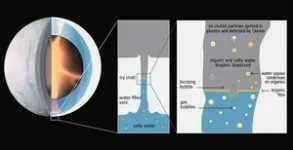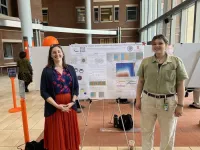(Press-News.org) CORVALLIS, Ore. – Arachnophobia can make humans flee at the sight of a brown recluse, black widow or even a daddy long legs, but animal predators of spiders know no such fear.
That’s why, paleobiologist George Poinar Jr. explains, some spider species have developed the defense of deception. They masquerade as a much less desirable prey – ants – and Poinar’s recent paper in Historical Biology presents an early record of an ant-mimicking spider in fossilized resin.
“Ants are particularly good creatures for spiders to pretend to be – many animals find ants distasteful or dangerous to eat,” said Poinar, who has a courtesy appointment in the Oregon State University College of Science. “Ants are aggressive in their own defense – they have a strong bite as well as a stinging venom, and they can call in dozens of nestmates as allies. Spiders, meanwhile, have no chemical defenses and are loners, which makes them vulnerable to being hunted by larger spiders, wasps and birds – predators that would rather avoid ants. So if a spider can be like an ant, it’s more likely to be unbothered.”
Spiders that disguise themselves as ants live in many locations around the globe but until now most had been able to avoid detection from fossil researchers as well as predators. The specimen that Poinar describes, which he named Myrmarachne colombiana, was entombed in a type of fossilized resin known as copal.
Copal is a less mature form of fossilized resin than amber, which is routinely dated to be 25 million or more years old. Still, copal can be up to 3 million years old.
The age of the resin in this case, however, could not be determined, said Poinar, an international expert in using plant and animal life forms preserved in amber to learn about the biology and ecology of the distant past.
The resin block he was working with, which came from Medellin, Colombia, was too small to age-test without risk of damaging the spider inside. Poinar notes there is no record of any currently living ant-mimicking spider making its home in Colombia.
“It is a challenge for spiders to accomplish this magical transformation to ants,” he said. “Ants have six legs and two long antennae, while spiders have eight legs and no antennae.”
To get around those anatomical differences, Poinar said, spiders typically position their two front legs in a way that approximates the look of antennae. But number of legs and absence/presence of antennae are not the only characteristics differentiating an ant’s appearance from a spider’s.
“The abdomen and cephalothorax of spiders are closely attached, while in ants the equivalent of these body parts are separated by a narrow segment called the petiole,” Poinar said. “And there are many other lesser structures that need to be modified in spiders for them to closely resemble ants. How is this accomplished? Most scientists say it begins with spider mutation, adaptation and then natural selection.
“However, I think there is some spider reasoning and intelligence involved too since the spiders often model their body changes after specific ants in the same environment,” he said. “In the early days, we were told that all habits of insects were the result of instincts, but that is no longer the case.”
Several groups of spiders have developed the ability to look and behave like various types of ants, he added. There are also spiders that try to blend in as other insects, such as flies, beetles and wasps.
Most of the copycat spiders belong to a few families of hunting spiders, including Salticidae or jumping spiders. The specimen in the Colombian copal appears to be a jumping spider.
Spiders that practice mimicry also come from the Corinnidae (sun spider), Thomisidae (flower spider) and Zodariidae (spotted or ant spider) families.
END
Research uncovers a rare resin fossil find: A spider that aspires to be an ant
2024-03-22
ELSE PRESS RELEASES FROM THIS DATE:
Research highlights importance of support reciprocity during early-stage dementia care
2024-03-22
In cases of Alzheimer’s disease, it’s common for a spouse to take on the role of caregiver. Research led by the University of California, Davis, suggests that patients can also support their caretakers, and that reciprocated care has mutual benefits.
A new paper published in the journal Aging and Mental Health highlights that couples coping with dementia can navigate the challenges with greater resilience and well-being by working together and supporting each other.
“We know that dementia is degenerative, there’s no way back, and spousal caregivers typically ...
New center positions UC Riverside as a leader in quantum vibronics
2024-03-22
RIVERSIDE, Calif. -- Physicist Nathaniel Gabor at the University of California, Riverside, has been awarded a $7.5M grant from the Department of Defense, or DoD, to develop a Multidisciplinary University Research Initiatives, or MURI, center on campus. Called QuVET for the Center for Quantum Vibronics in Energy and Time, the center’s co-principal investigators are leading scientists at UCR, Caltech, MIT, and Columbia University.
“Vibronic,” a portmanteau of vibrational and electronic, refers to transitions between molecular energy states. ...
MSU offers first study on teacher effectiveness for students with and without disabilities
2024-03-22
MSU has a satellite uplink/LTN TV studio and Comrex line for radio interviews upon request.
EAST LANSING, Mich. – Research has often focused on how teachers and educators can best instruct and accommodate students with disabilities. However, are the methods used to teach students with disabilities effective and inclusive for all students? Michigan State University researchers are some of the first to answer that question.
Faculty and doctoral students from across MSU, including from the College of Social Science and the College of ...
Molecular & Cellular Proteomics names new editor-in-chief
2024-03-22
The American Society for Biochemistry and Molecular Biology announced today that Ileana Cristea, professor of molecular biology and director of graduate studies at Princeton University, will be the next editor-in-chief of Molecular & Cellular Proteomics, one of the society’s three open-access, peer-reviewed journals. Cristea’s five-year term will begin Aug. 12.
Cristea has a long relationship with the journal. She has been a member of the editorial board since 2011, and she served as the editor for the MCP special issue, “Proteomics in Infectious Disease” in 2017.
Her research lies ...
DayCent-CABBI: new model integrates soil microbes, large perennial grasses
2024-03-22
Of all the carbon stored in ecosystems around the world, about half can be found in soils. Depending on climate, vegetation, and management, soils can be either a carbon source or a sink.
Natural climate solutions (NCS) offer a promising opportunity to bring us closer to our net-zero emissions goals by removing carbon dioxide from the atmosphere and storing it in plant biomass and soil. The growth of bioenergy feedstocks has great potential in this regard, because these grasses both build soil carbon and have the potential to be used to produce carbon-neutral biofuels and bioproducts.
Over ...
Maple syrup producers provide sweet news for threatened birds
2024-03-22
The summer mating season is looking to get a lot easier for the scarlet tanager, one of a number of migratory songbirds that use the forests of northeastern North America to find a mate.
In recent decades, the loss and degradation of bird habitats has led to a precipitous decline in bird populations. Now, a $2 million grant awarded to the National Audubon Society’s Bird-Friendly Maple program, in partnership with College of Natural Resources and Environment Associate Professor Ashley Dayer, will look to improve bird habitats by encouraging maple syrup producers to incorporate forest management practices that allow other ...
Neighborhood-level poverty and food insecurity during pregnancy associated with lower birthweight and small for gestational age infants, NIH study finds
2024-03-22
Living in neighborhoods where residents have lower incomes and limited food access during pregnancy was associated with an increased risk of babies born small for gestational age or with lower birthweight, according to a new study from the NIH Environmental Influences on Child Health Outcomes (ECHO) Program.
Previous studies have shown that maternal diet during pregnancy can impact the physical and mental health of a mother. However, less is known about how food insecurity affects health outcomes for newborns. In a new research article, ECHO researchers analyzed data to understand what connections might exist between where a pregnant ...
Using physics principles to understand how cells self-sort in development
2024-03-22
Erin McCarthy ’23, physics summa cum laude, is a rarity among young scientists. As an undergraduate researcher in Syracuse University's College of Arts & Sciences’ Department of Physics, she guided a study that appeared in March 2024 in Physical Review Letters. It is the most-cited physics letters journal and the eighth-most cited journal in science overall.
McCarthy and postdoctoral associates Raj Kumar Manna and Ojan Damavandi developed a model that identified an unexpected collective ...
SFU Publishing Director Hannah McGregor's new book asks "Can podcasting save academia?"
2024-03-22
A new book from Lori Beckstead, Ian M. Cook, and SFU Publishing Director Hannah McGregor, explores how the growth of scholarly podcasting may engender radical possibilities for how we conceive of knowledge creation and peer review, and the transformative potential of new modes of creating and reviewing expert knowledge.
"Podcast Or Perish" investigates the historical development of the norms of scholarly communication and asks how podcasting might change how we think about scholarly work. Could this be the call to action academia needs?
Read ...
Early intervention after the first seizure may prevent long-term epilepsy and associated cognitive deficits
2024-03-22
PHILADELPHIA— Only a very small percentage of neurons show changes after an epileptic seizure in mice, but these alterations can be permanent and trigger future seizures that can affect the whole brain and lead to impaired cognition, like memory and learning, according to new research from the Perelman School of Medicine at the University of Pennsylvania. The researchers identified an experimental treatment that, if provided within the first 48 hours after the first seizure, can prevent these long-term changes. The findings, which were published recently in The ...








